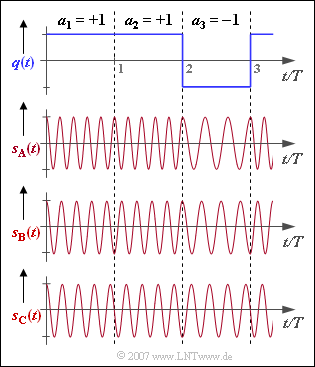Exercise 3.4Z: Continuous Phase Frequency Shift Keying
The graph shows three frequency shift keying (FSK) transmitted signals which differ with respect to the frequency deviation ΔfA distinguish and thus also by their modulation index
- h=2⋅ΔfA⋅T.
The digital source signal q(t) underlying the signals sA(t),sB(t) and sC(t) is shown above. All considered signals are normalized to amplitude 1 and time duration T and based on a cosine carrier with frequency fT.
With binary FSK ("Binary Frequency Shift Keying") only two different frequencies occur, each of which remains constant over a bit duration:
- f1 (if aν=+1),
- f2 (if aν=−1).
If the modulation index is not a multiple of 2, continuous phase adjustment is required to avoid phase jumps. This is called "Continuous Phase Frequency Shift Keying" (CP-FSK).
An important special case is represented by binary FSK with modulation index h=0.5 which is also called "Minimum Shift Keying" (MSK). This will be discussed in this exercise.
Hints:
- This exercise belongs to the chapter "Radio Interface".
- Reference is made in particular to the section "Continuous phase adjustment with FSK.
Questions
Solution
- Generally nonlinear FSK can only be demodulated coherently, while MSK can also use a noncoherent demodulation method.
- Compared to QPSK with coherent demodulation, MSK requires 3 dB more EB/N0 (energy per bit related to the noise power density) for the same bit error rate.
- The first zero in the power density spectrum occurs later in MSK than in QSPK, but it shows a faster asymptotic decay than in QSPK.
- The constant envelope of MSK means that nonlinearities in the transmission line do not play a role. This allows the use of simple and inexpensive power amplifiers with lower power consumption and thus longer operating times of battery-powered devices.
(2) One can see from the graph five and three oscillations per symbol duration, respectively:
- f1⋅T=5_,f2⋅T=3_.
(3) For FSK with rectangular pulse shape, only the two instantaneous frequencies f1=fT+ΔfA and f2=fT−ΔfA occur.
- With the result from (2) we thus obtain:
- fT = f1+f22⇒fT⋅T=4_,
- ΔfA = f1−f22⇒ΔfA⋅T=1_,
- h = 2⋅ΔfA⋅T=2_.
(4) From the graph one can see the frequencies f1⋅T=4.5 and f2⋅T=3.5.
- This results in the frequency deviation ΔfA⋅T=0.5 and the modulation index h=1_.
(5) Here the two (normalized) frequencies f1⋅T=4.25 and f2⋅T=3.75 occur,
- which results in the frequency deviation ΔfA⋅T=0.25 and the modulation index h=0.5_ can be calculated.
(6) Correct are the solutions 2 and 3:
- Only at sA(t) was no phase adjustment made.
- Here, the signal waveforms in the region of the first and second bit (a1=a2=+1) are each cosinusoidal like the carrier signal (with respect to the symbol boundary).
- In contrast, in the second symbol of sB(t) a minus-cosine-shaped course (initial phase \phi_{0} = π corresponding to 180^\circ) can be seen and in the second symbol of s_{\rm C}(t) a minus-sine-shaped course (\phi_{0} = π /2 or 90^\circ).
- For s_{\rm A}(t) the initial phase is always 0, for s_{\rm B}(t) either 0 or π, while for the signal s_{\rm C}(t) with modulation index h = 0.5 a total of four initial phases are possible: 0^\circ, \ 90^\circ, \ 180^\circ and 270^\circ.
(7) Correct is the last proposed solution, since for this signal h = 0.5 holds.
- This is the smallest possible modulation index for which there is orthogonality between f_{1} and f_{2} within the symbol duration T.
